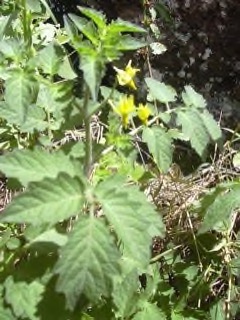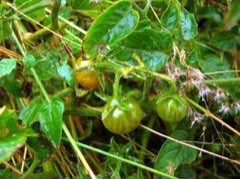 |
|
Forest & Kim Starr wikimedia.org |
 |
| Forest & Kim Starr wikimedia.org |
Translate this page:
Summary
Currant Tomato, Solanum pimpinellifolium, is a wild tomato species native to Ecuador and Peru. There are annual. biennial, and perennial varieties. Other common names are German Raising Tomato and Tomatillo. The branches are slender and initially erect, becoming procumbent or decumbent. The fruits are small, red, globose and edible. It can be eaten raw, cooked, or dried for later use. The seeds yield edible oil which can also be used in making soap. The fruits have medicinal uses as well. It can be used as first aid treatment for burns, scalds, and sunburn. It is also used in the treatment of rheumatism and headaches. Root decoction is ingested to relieve toothache.
Physical Characteristics

 Solanum_pimpinellifolium is a ANNUAL/BIENNIAL growing to 1 m (3ft 3in) by 0.5 m (1ft 8in) at a fast rate.
Solanum_pimpinellifolium is a ANNUAL/BIENNIAL growing to 1 m (3ft 3in) by 0.5 m (1ft 8in) at a fast rate.
See above for USDA hardiness. It is hardy to UK zone 10. The flowers are pollinated by Insects. The plant is self-fertile.
Suitable for: light (sandy), medium (loamy) and heavy (clay) soils and prefers well-drained soil. Suitable pH: mildly acid, neutral and basic (mildly alkaline) soils. It cannot grow in the shade. It prefers moist soil.
UK Hardiness Map
US Hardiness Map
Synonyms
Lycopersicon esculentum pimpinellifolium (Jusl.) Mill. Lycopersicon pimpinellifolium (L.) Mill. Lyco
Plant Habitats
Edible Uses
Fruit - raw, cooked or dried for later use[1 , 105 , 183 ]. Sweet and delicious, it makes an excellent dessert fruit and is also used in savoury dishes as a vegetable[K ]. The red, globose fruit is rather small and fiddly, about 10 - 15mm in diameter, but it is produced in quite large bunches and is well worth the effort of picking[K ]. An edible oil is obtained from the seed[46 , 61 ]. The seed is small and it would be very fiddly to utilize. It is only viable to use the seed as a source of oil if large quantities of the plants are being grown for their fruits and the seed is not wanted.
References More on Edible Uses
Medicinal Uses
Plants For A Future can not take any responsibility for any adverse effects from the use of plants. Always seek advice from a professional before using a plant medicinally.
The pulped fruit is an extremely beneficial skin-wash for people with oily skin. Sliced fruits are a quick and easy first aid treatment for burns, scalds and sunburn[201 ]. A decoction of the root is ingested in the treatment of toothache[218 ]. The skin of tomato fruits is a good source of lycopine, a substance that has been shown to protect people from heart attacks. It seems to be more effective when it is cooked and so can be obtained from food products such as tomato ketchup and tinned tomatoes[246 ]. A homeopathic remedy is made from the plant[7 ]. It is used in the treatment of rheumatism and severe headaches[7 ].
References More on Medicinal Uses
The Bookshop: Edible Plant Books
Our Latest books on Perennial Plants For Food Forests and Permaculture Gardens in paperback or digital formats.

Edible Tropical Plants
Food Forest Plants for Hotter Conditions: 250+ Plants For Tropical Food Forests & Permaculture Gardens.
More

Edible Temperate Plants
Plants for Your Food Forest: 500 Plants for Temperate Food Forests & Permaculture Gardens.
More

More Books
PFAF have eight books available in paperback and digital formats. Browse the shop for more information.
Shop Now
Other Uses
Agroforestry Uses: The strong aroma of this plant is said to repel insects from nearby plants[7 , 18 , 20 ]. Other Uses A semi-drying oil is obtained from the seed. Used in making soap[46 , 61 , 171 ]. See the notes above regarding utilization.
Special Uses
References More on Other Uses
Cultivation details
Plants are not frost-hardy. They can be grown outdoors in Britain as a spring-sown annual started off under glass in the spring. In cool wet summers the total yields are likely to be low[K ]. Requires a rich well-drained soil in a sunny position. The plant has been introduced as a crop into the Galapagos, where it has shown a tendency to invade disturbed areas. It is of particular concern there due to possible hybridization with native Solanaceae[305 ]. There are some named varieties[183 ].
References Carbon Farming Information and Carbon Sequestration Information
Temperature Converter
Type a value in the Celsius field to convert the value to Fahrenheit:
Fahrenheit:
The PFAF Bookshop
Plants For A Future have a number of books available in paperback and digital form. Book titles include Edible Plants, Edible Perennials, Edible Trees,Edible Shrubs, Woodland Gardening, and Temperate Food Forest Plants. Our new book is Food Forest Plants For Hotter Conditions (Tropical and Sub-Tropical).
Shop Now
Plant Propagation
Seed - sow in situ The seedcoat may carry tomato mosaic virus. However, by sowing the seed 15mm deep the seedcoat will remain below the soil surface when the seed germinates and the disease will be inactivated[124 ].
Other Names
If available other names are mentioned here
Mantathur chin,
Native Plant Search
Search over 900 plants ideal for food forests and permaculture gardens. Filter to search native plants to your area. The plants selected are the plants in our book 'Plants For Your Food Forest: 500 Plants for Temperate Food Forests and Permaculture Gardens, as well as plants chosen for our forthcoming related books for Tropical/Hot Wet Climates and Mediterranean/Hot Dry Climates. Native Plant Search
Found In
Countries where the plant has been found are listed here if the information is available
Australia, Andes, Brazil, Ecuador, India, Mexico, North America, Northeastern India, Peru, South America, USA.
Weed Potential
Right plant wrong place. We are currently updating this section.
Please note that a plant may be invasive in one area but may not in your area so it’s worth checking.
The plant has been introduced as a crop into the Galapagos, where it has shown a tendency to invade disturbed areas. It is of particular concern there due to possible hybridization with native Solanaceae[305 ].
Conservation Status
IUCN Red List of Threatened Plants Status : This taxon has not yet been assessed

Growth: S = slow M = medium F = fast. Soil: L = light (sandy) M = medium H = heavy (clay). pH: A = acid N = neutral B = basic (alkaline). Shade: F = full shade S = semi-shade N = no shade. Moisture: D = dry M = Moist We = wet Wa = water.

Expert comment
Author
L.
Botanical References
Links / References
For a list of references used on this page please go here
A special thanks to Ken Fern for some of the information used on this page.
Readers comment
| Add a comment |
|
If you have important information about this plant that may help other users please add a comment or link below. Only comments or links that are felt to be directly relevant to a plant will be included. If you think a comment/link or information contained on this page is inaccurate or misleading we would welcome your feedback at [email protected]. If you have questions about a plant please use the Forum on this website as we do not have the resources to answer questions ourselves.
* Please note: the comments by website users are not necessarily those held by PFAF and may give misleading or inaccurate information.
To leave a comment please Register or login here All comments need to be approved so will not appear immediately.
|
Subject : Solanum_pimpinellifolium
|
|
|
|